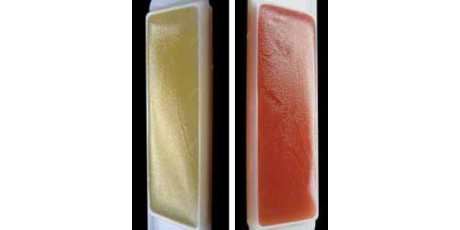Samenvatting
Den Heijer CDJ, Van Dongen MCJM, Donker GA, Stobberingh EE. Diagnosis of urinary tract infections in men. Huisarts Wet 2014;57(8):390-4.
Aim
The diagnosis of urinary tract infection (UTI) in men can lead to overtreatment in general practice. We developed a decision algorithm based on dipstick testing and age (> 60 years) and investigated whether use of the algorithm altered patient management relative to usual practice.
Design
Surveillance study (Dutch Sentinel General Practice Network) over the period January 2009 to July 2011. Dipstick results and other clinical information were obtained from participating general practitioners. A cut-off value of 103 cfu/ml urine was used to confirm the diagnosis UTI. Algorithm-predicted care was compared with usual care in terms of sensitivity (antibiotic recommended when UTI was confirmed) and specificity (no antibiotic recommended when no UTI was observed).
Results
Complete data were available for 490 of 603 (81%) men and a UTI was confirmed in 66% (321/490) of these men. The diagnostic algorithm recommended treatment with antibiotics for patients with a positive nitrite test and for men older than 60 years with a positive leucocyte esterase test. The chance of a UTI was 40% when dipstick tests (nitrite and leucocytes) were negative in the group as a whole and 29% in men younger than 60 years. The sensitivity and specificity of the UTI diagnostic algorithm were not different from those of usual care (75% versus 79%, and 70% versus 63%, respectively, both p > 0.05).
Conclusion
Use of this UTI diagnostic algorithm did not improve the treatment of UTI in men. If UTI remains suspected even though dipstick results are negative, a wait-and-see policy regarding empirical antibiotic use is warranted, given the low likelihood of an infection.
Wat is bekend?
-
Beslisregels op basis van klinische informatie en dipsticktests verbeteren de diagnostiek van urineweginfecties bij vrouwen.
-
Voor mannen zijn dergelijke beslisregels er niet.
-
De resultaten van onderzoek bij vrouwen kunnen niet zonder meer vertaald worden naar mannen.
Wat is nieuw?
-
De beste voorspellers voor een urineweginfectie bij mannelijke huisartspatiënten zijn positieve dipsticktests (nitriet en leukocytenesterase) en een leeftijd boven de 60 jaar.
-
Een beslisregel op basis van deze criteria verandert echter niets aan het gebruikelijke beleid.
-
In weerwil van de NHG-Standaard Urineweginfecties kan de huisarts bij mannen met negatieve dipsticktests die jonger zijn dan 60 jaar het best de kweek afwachten alvorens te starten met antibiotica.
Achtergrond
Urineweginfecties (UWI’s) zijn veelvoorkomende bacteriële infecties, die bij vrouwen vaker optreden dan bij mannen.1 Mede hierdoor is over diagnostiek en beleid bij mannen veel minder gepubliceerd dan bij vrouwen.2 Bij mannen neemt de incidentie van UWI’s toe na het 60e levensjaar, vermoedelijk doordat benigne prostaathypertrofie op deze leeftijd vaker voorkomt.3 De hypertrofie zorgt voor stasis van de urine en dat verhoogt het risico op infectie. Bij 90% van de mannen met koorts en UWI-klachten blijkt de prostaat daarbij betrokken te zijn.4
Volgens de recentelijk herziene NHG-Standaard Urineweginfecties behoren mannen – samen met zwangeren, patiënten met een verblijfskatheter en personen met diabetes mellitus of een urologische of nefrologische comorbiditeit – tot de groep risicopatiënten voor een UWI. Toch is de standaard grotendeels onderbouwd met onderzoeken die zijn verricht bij vrouwen.1 Het is goed mogelijk dat de resultaten van deze onderzoeken, gegeven de anatomische verschillen en de leeftijdgebonden verschillen in incidentie, niet zonder meer van toepassing zijn op mannen. Daarom is dit onderzoek speciaal gericht op de diagnostiek van UWI-klachten bij mannen.
Wij hebben aan de hand van diagnostische informatie – zowel klinische informatie als dipsticktests – een beslisregel opgesteld voor het (empirisch) voorschrijven van antibiotica aan mannen met UWI-klachten. In een Amerikaans onderzoek is gebleken dat een dergelijke beslisregel voor vrouwen met UWI-klachten het aantal aangevraagde urinekweken en onterechte antibioticumvoorschriften kan verminderen zonder dat dat leidt tot substantiële onderbehandeling van daadwerkelijke infecties.5
Om de meerwaarde van onze beslisregel voor de Nederlandse mannelijke huisartspopulatie te bepalen, vergeleken wij het hieruit voortvloeiende beleid met de huidige dagelijkse praktijk. De NHG-Standaard Urineweginfecties adviseert een man bij wie de verdenking op een UWI bestaat, ongeacht de dipstickuitslagen, standaard empirisch met een antibioticum te behandelen.1 Onze beslisregel zou bij koortsvrije patiënten kunnen helpen bepalen wanneer afwachtend beleid acceptabel is, en daarmee houvast kunnen geven aan huisartsen en patiënten die liever niet onnodig antibiotica gebruiken.
Methode
Deelnemers
De inclusie van deelnemers werd uitgevoerd door 42 huisartsen die participeren in de peilstations van NIVEL Zorgregistraties eerste lijn. De patiëntenpopulatie van deze peilstations omvat 0,8% van de Nederlandse bevolking en is zo opgebouwd dat leeftijd, geslacht, regionale verdeling en bevolkingsdichtheid vergelijkbaar zijn met die van de totale Nederlandse bevolking.6
De huisartsen includeerden alle mannelijke patiënten van 18 jaar en ouder die van januari 2009 tot en met juni 2011 op consult kwamen met UWI-klachten (pijnlijke of branderige mictie, verhoogde mictiefrequentie of loze aandrang). Patiënten met urologische of nefrologische comorbiditeit – met uitzondering van benigne prostaathypertrofie – werden geëxcludeerd, evenals patiënten met diabetes mellitus of andere immuuncompromitterende ziekten, patiënten met een (verblijfs)katheter en patiënten bij wie verdenking bestond op een seksueel overdraagbare aandoening (soa).
Klinische informatie en dipsticktests
Voor iedere patiënt noteerde de huisarts leeftijd, geslacht en dipstickresultaten voor nitriet en leukocytenesterase (LE), evenals de aan- of afwezigheid van pijnlijke of branderige mictie, verhoogde mictiefrequentie, loze aandrang, koorts > 38 °C en flankpijn. Tevens gaf de huisarts aan of de patiënt in het voorafgaande jaar een UWI had doorgemaakt. De dipsticktest werd uitgevoerd met vers geloosde urine, waarbij iedere kleuromslag van de dipstick werd beschouwd als positief resultaat.7
Het wel of niet voorschrijven van een antibioticum, zoals door de huisarts aangegeven, beschouwden we als gebruikelijke zorg.
Urinekweek
In de huisartsenpraktijk werd een vers urinemonster aangebracht op een dipslide (Uriline 56508, Biomérieux, Plainview NY) en voor analyse verstuurd naar de afdeling Medische Microbiologie van het Maastricht Universitair Medisch Centrum. Wanneer op de dipslide ten minste 103 kolonievormende eenheden per ml (kve/ml) werden aangetroffen, beschouwden wij dit als een microbiologisch bevestigde UWI.89
Beslisregel
Wij formuleerden een beslisregel voor mannen met UWI-klachten op de wijze die beschreven is door Little et al.,10 zonder echter voor iedere voorspellende factor een likelihood ratio te berekenen. Vooraf bepaalden wij met behulp van multivariabele logistische regressie de voorspellende waarde van de afzonderlijke symptomen en dipstickuitslagen. Alleen variabelen met een significant voorspellende waarde voor een UWI (p < 0,05) werden opgenomen in de beslisregel. Van de leeftijd maakten wij een dichotome variabele met als afkappunt 60 jaar, aangezien binnen de onderzoekspopulatie de kans op een UWI vanaf die leeftijd aanzienlijk toenam.
Afhankelijk van de sterkte van de voorspellende waarde kenden wij aan iedere significante UWI-voorspeller een gewicht toe op basis van de bètacoëfficiënt uit de logistische regressieanalyse, afgerond tot een geheel getal (een bètacoëfficiënt van 2,02 geeft het gewicht 2). Wij optimaliseerden de beslisregel door van iedere mogelijke combinatie van gewichten de waarde te bepalen als criterium voor de beslissing om wel of niet een antibioticum voor te schrijven. Voor ieder aldus bepaald afkappunt berekenden we de positief voorspellende waarde (PVW), de negatief voorspellende waarde (NVW), de sensitiviteit, de specificiteit en het percentage correct geclassificeerde patiënten (wel of niet een antibioticum).
Tabel1Voorspellende factoren voor een urineweginfectie bij mannenOpen tabel
| Diagnostische informatie (bètacoëfficiënt) | UWI (n = 321)† | Geen UWI (n = 169)† | OR (95%-BI) | Gewicht‡ |
|---|---|---|---|---|
| Verhoogde mictiefrequentie | 40% | 34% | 0,83 (0,51 tot 1,34) | – |
| Pijnlijke/branderige mictie | 60% | 50% | 1,35 (0,86 tot 2,11) | – |
| Loze aandrang | 33% | 22% | 1,40 (0,84 tot 2,33) | – |
| Koorts > 38 °C | 16% | 7% | 1,58 (0,73 tot 3,39) | – |
| Flankpijn | 15% | 15% | 1,42 (0,77 tot 2,63) | – |
| Leeftijd > 60 jaar (0,75) | 70% | 47% | 2,11 (1,35 tot 3,31) | 1 |
| UWI in voorafgaande jaar | 32% | 22% | 1,03 (0,62 tot 1,71) | – |
| Nitriet (2,02) | 58% | 12% | 7,54 (4,34 tot 13,09) | 2 |
| LE (0,52) | 76% | 48% | 1,68 (1,06 tot 2,69) | 1 |
UWI = urineweginfectie; OR = oddsratio; BI = betrouwbaarheidsinterval; LE = leukocytenesterase.* De bètacoëfficiënt uit de multivariabele logistische regressieanalyse is alleen weergegeven voor factoren met een significant voorspellende waarde.† Microbiologisch bevestigd door een kweekresultaat van = 103 kve/ml.‡ De significante voorspellers van UWI hebben in de beslisregel een gewicht dat gelijk is aan de bètacoëfficiënt, afgerond naar het naastbijgelegen gehele getal.
Tabel2Diagnostische parameters van een beslisregel voor urineweginfectie bij mannenOpen tabel
| Afkappunt | Parameter | Patiënten boven afkappunt | Sensitiviteit (95%-BI) | Specificiteit (95%-BI) | PVW (95%-BI) | NVW (95%-BI) | Patiënten correct geclassificeerd |
|---|---|---|---|---|---|---|---|
| = 0 | 100% | 100 | 0 | – | – | 65,5% | |
| = 1 | L of A | 85,3% | 94 (90 tot 96) | 30 (24 tot 38) | 72 (67 tot 76) | 71 (59 tot 81) | 71,2% |
| = 2 | N of (L + A) | 59,6% | 75 (70 tot 80) | 70 (62 tot 77) | 83 (78 tot 87) | 60 (52 tot 66) | 73,3% |
| = 3 | (N + L) of(N + A) | 40,4% | 56 (50 tot 61) | 89 (83 tot 93) | 90 (85 tot 94) | 51 (46 tot 57) | 67,1% |
| = 4 | N + L + A | 26,9% | 37 (32 tot 43) | 92 (87 tot 96) | 90 (83 tot 94) | 44 (38 tot 49) | 56,1% |
BI = betrouwbaarheidsinterval; NVW = negatief voorspellende waarde; PPV = positief voorspellende waarde.Het afkappunt geeft aan vanaf welke score de beslisregel een antibioticum zou aanbevelen. De score is gebaseerd op de wegingsfactoren uit [tabel 1]: nitriet (N) = 2; leukocytenesterase (L) = 1; leeftijd > 60 jaar (A) = 1. Voorbeeld: de score 3 kan behaald worden met een positieve nitriettest (2) en een postieve leukocytentest (1), of door een positieve nitriettest (2) en een leeftijd boven de 60 jaar (1). Het hoogste percentage correct geclassificeerde patiënten wordt behaald met afkappunt = 2 [figuur].
Vergelijking met gebruikelijke zorg
Wij evalueerden de potentiële meerwaarde van de beslisregel door de sensitiviteit en specificiteit van de beslisregel te vergelijken met die van de gebruikelijke zorg. Daarbij definieerden wij sensitiviteit als het percentage mannen met een microbiologisch bevestigde UWI bij wie de beslisregel een antibioticum aanbeval, dan wel het percentage aan wie de huisarts in het kader van de gebruikelijke zorg een antibioticum voorschreef. Specificiteit definieerden we als het percentage mannen zonder microbiologisch bevestigde UWI bij wie de beslisregel geen antibioticum aanbeval, versus het percentage aan wie de huisarts in het kader van de gebruikelijke zorg geen antibioticum voorschreef. Een p < 0,05 beschouwden we als statistisch significant.
Het programma SPSS 16.0 werd gebruikt voor de statistische analyses.
Resultaten
Deelnemers
De 42 huisartsen includeerden in totaal 603 patiënten. Voor 490 deelnemers (81%) beschikten wij over de complete gegevens (symptomatologie en dipstick); alleen deze deelnemers werden meegenomen in de verdere analyses. De gemiddelde leeftijd van de 113 patiënten met ontbrekende gegevens verschilde niet van die van de geanalyseerde 490 deelnemers (62,5 versus 62,9 jaar, p > 0,05).
Wij herhaalden de gepresenteerde analyses voor de patiënten van wie we alleen de symptomatologie compleet hadden (n = 562) en voor de patiënten van wie alleen de dipstickgegevens compleet waren (n = 527). In deze analyses veranderden de uitkomsten niet significant (gegevens niet getoond).11
Van de 490 geïncludeerde deelnemers hadden er 321 (66%) een positieve urinekweek (> 103 kve/ml).
Beslisregel
Nitriet bleek in dit onderzoek de sterkste UWI-voorspeller te zijn, met een oddsratio (OR) van 7,54 bij een 95%-betrouwbaarheidsinterval (95%-BI) van 4,34 tot 13,09. Patiënten met een positieve nitriettest hebben een veel grotere kans op een UWI dan patiënten met een negatieve nitriettest [tabel 1]. Wij vonden twee andere significante UWI-voorspellers, namelijk een positieve leukocytenesterasetest (OR 1,68; 95%-BI 1,06 tot 2,69) en leeftijd ouder dan 60 jaar (OR 2,11; 95%-BI 1,35 tot 3,31). Ook deze factoren namen wij op in de beslisregel. Geen enkel ander klinisch symptoom bleek voorspellende waarde te hebben voor een UWI.
Bij de evaluatie van de verschillende beslisregels bleek een positieve nitriettest, dan wel een positieve leukocytenesterasetest in combinatie met leeftijd > 60 jaar, relatief het vaakst een correcte indicatie voor een antibioticum te geven [tabel 2]. De beslisregel die daaruit voortvloeit, staat weergegeven in de [figuur].
Een negatieve nitriettest in combinatie met een negatieve leukocytentest doet de kans op een UWI dalen tot 40%, en zelfs tot 29% bij mannen jonger dan 60 jaar.
Vergelijking met gebruikelijke zorg
Het beleid op basis van de beslisregel week niet af van de gebruikelijke zorg. Het percentage mannen met een UWI bij wie de beslisregel een antibioticum aanbeval (75%), verschilde niet significant van het percentage antibioticumvoorschriften bij gebruikelijke zorg (79%, p > 0,05). Ook het percentage patiënten zonder UWI bij wie de beslisregel geen antibioticum aanbeval (70%) verschilde niet significant van het percentage bij gebruikelijke zorg (63%, p > 0,05).
Beschouwing
In de onderzochte Nederlandse huisartsenpraktijken geeft een diagnostische beslisregel voor mannen met UWI-klachten, gebaseerd op leeftijd en een nitriet- en leukocytentest, geen ander resultaat dan de gebruikelijke zorg in termen van (empirische) behandeling met antibiotica. Wel blijkt uit het onderzoek dat de kans op een UWI bij patiënten jonger dan 60 jaar die geen koorts hebben en bij wie de dipsticktests negatief zijn, relatief klein is. Als bij deze patiënten toch een klinische verdenking op een UWI bestaat, zou men het best de kweekuitslag kunnen afwachten alvorens met antibiotica te beginnen.
Een sterk punt van dit onderzoek is de inclusie van patiënten via huisartsen verbonden aan de NIVEL-peilstations. De onderzoeksresultaten zijn daardoor representatief voor de gehele volwassen mannelijke eerstelijnspopulatie in Nederland. Een ander sterk punt is dat een vergelijkbare systematische beslisregel voor UWI’s bij mannen naar ons weten nog niet eerder is opgesteld.
Een mogelijke beperking van het onderzoek is het ontbreken van hematurie bij de evaluatie van de dipstickresultaten. De voorspellende waarde van hematurie staat beschreven in de literatuur,110 waarbij moet worden aangetekend dat het daar vrouwen betreft en dat de diagnostische waarde van hematurie bij mannen nog niet is geëvalueerd. Onze diagnostische keuzen zijn gebaseerd op de tweede herziening van de NHG-Standaard Urineweginfecties; ook in de thans geldende derde herziening is hematurie niet opgenomen in de beslisregel voor mannen.112
In onze beslisregel voor UWI bij mannen hebben we een afkapwaarde van 103 kve/ml urine aangehouden voor het vaststellen van een UWI. Daarin zijn wij afgeweken van de NHG-Standaard, die een afkapwaarde hanteert van 104 kve/ml.1 In de literatuur echter is de waarde van low-count-bacteriurie (102-104 kve/ml) voor zowel mannen als vrouwen beschreven, en de Europese richtlijnen bevelen 103 kve/ml aan als afkappunt voor een UWI veroorzaakt door Escherichia coli, het belangrijkste uropathogeen.8913
Een onderzoek uit 2004 in Nederlandse huisartsenpraktijken bevestigde dat positieve dipsticktests (en dan met name nitriet) een sterke voorspeller zijn voor een UWI.14 In Duits onderzoek is de voorspellende waarde van dipsticktests lager gebleken, maar dat was in een onderzoekspopulatie die ook patiënten omvatte met comorbiditeit zoals diabetes mellitus, en patiënten met een (verblijfs)katheter. Wel werd in dit Duitse onderzoek gevonden dat leeftijd (ouder dan 60 jaar) een voorspellende factor is voor een UWI.2 Nu kan een positieve kweek bij oudere patiënten vaker het gevolg zijn van contaminatie, maar dit geldt vooral voor ouderen die incontinent zijn.15 Door de in- en exclusiecriteria bestond onze onderzoekspopulatie uit relatief gezonde personen, bij wie de kans op contaminatie klein is.
Bij het opstellen van onze beslisregel bleek dat geen enkel klinisch symptoom voorspellend was voor een UWI. Dit is eerder gesignaleerd en een mogelijke verklaring is dat de diagnostische informatie van de symptomen reeds is ‘verbruikt’ wanneer de patiënt in de spreekkamer zit, aangezien de symptomen juist de reden waren voor het aanvragen van het consult.16
De NHG-Standaard deelt mannen in bij de ‘risicogroepen’, voor wie hetzelfde beleid geldt als voor zwangere vrouwen en patiënten met diabetes mellitus. Voor deze laatste groepen is wetenschappelijk aantgetoond dat het risico op complicaties bij een UWI verhoogd is.17 Empirische antimicrobiële behandeling bij verdenking op een UWI is derhalve verantwoord bij deze patiënten. Voor mannen echter is een verhoogd risico niet bewezen, behalve dat de prostaat betrokken kan zijn bij het proces en dan voornamelijk bij mannen met koorts.4
Aangezien de resistentie tegen antibiotica in de bevolking toeneemt, is terughoudendheid geboden bij antibioticagebruik, zo lang als dat klinisch verantwoord is. De in ons onderzoek gebruikte beslisregel laat zien bij welke groep patiënten de kans op een UWI beperkt is en het risico op onnodig antibioticagebruik dus verhoogd. Huisartsen zouden de beslisregel kunnen gebruiken wanneer zij op klinische gronden van mening zijn dat afwachtend beleid verantwoord is, bijvoorbeeld bij afwezigheid van koorts of andere tekenen van weefselinvasie.
Conclusie
De klinische diagnose van de huisarts bij mannen met UWI-klachten is adequaat, maar indien de patiënt koortsvrij is en de huisarts op klinische gronden afwachtend beleid gerechtvaardigd vindt, kan onze beslisregel daarbij extra houvast bieden.
Reacties
Er zijn nog geen reacties.




